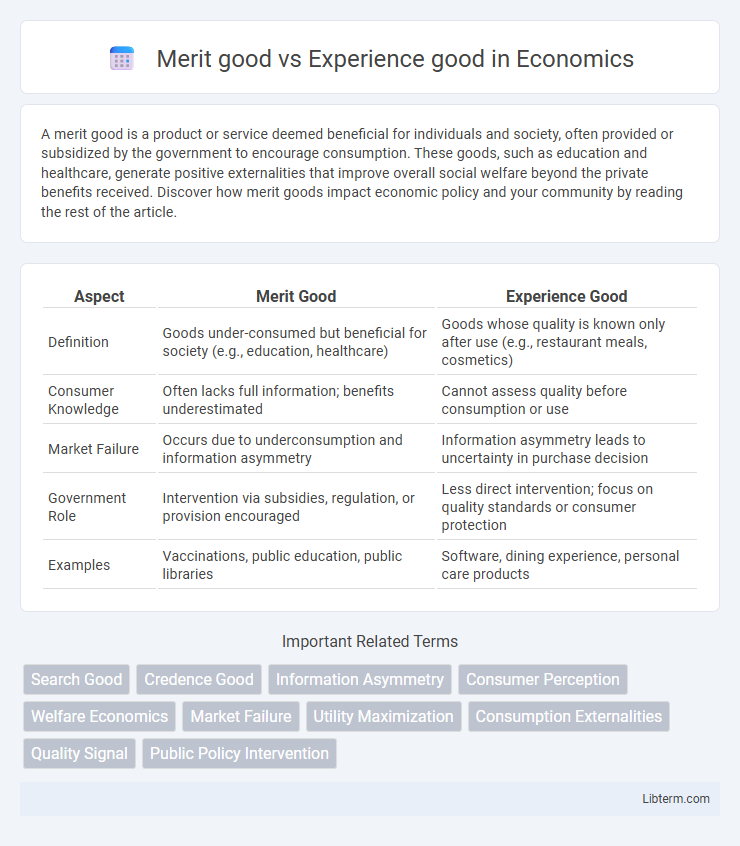A merit good is a product or service deemed beneficial for individuals and society, often provided or subsidized by the government to encourage consumption. These goods, such as education and healthcare, generate positive externalities that improve overall social welfare beyond the private benefits received. Discover how merit goods impact economic policy and your community by reading the rest of the article.
Table of Comparison
| Aspect | Merit Good | Experience Good |
|---|---|---|
| Definition | Goods under-consumed but beneficial for society (e.g., education, healthcare) | Goods whose quality is known only after use (e.g., restaurant meals, cosmetics) |
| Consumer Knowledge | Often lacks full information; benefits underestimated | Cannot assess quality before consumption or use |
| Market Failure | Occurs due to underconsumption and information asymmetry | Information asymmetry leads to uncertainty in purchase decision |
| Government Role | Intervention via subsidies, regulation, or provision encouraged | Less direct intervention; focus on quality standards or consumer protection |
| Examples | Vaccinations, public education, public libraries | Software, dining experience, personal care products |
Understanding Merit Goods: Definition and Characteristics
Merit goods are products or services deemed beneficial by society and often underconsumed if left to private markets, such as education and healthcare. They possess characteristics like positive externalities, where the social benefits exceed private benefits, leading to government intervention to ensure wider access. Understanding merit goods involves recognizing their role in promoting social welfare and correcting market failures through subsidies, public provision, or regulation.
Experience Goods Explained: Key Features and Examples
Experience goods are products or services whose quality and value can only be assessed after consumption, making consumer experience crucial for purchase decisions. Key features include uncertainty before use, reliance on past usage or reviews, and the importance of brand reputation in reducing perceived risk. Examples of experience goods include restaurant meals, vacations, and software subscriptions where user satisfaction becomes apparent post-consumption.
Core Differences Between Merit Goods and Experience Goods
Merit goods are products or services deemed beneficial for individuals and society, such as education and healthcare, often provided or subsidized by the government regardless of consumer demand. Experience goods, like restaurants or vacations, require consumption for consumers to evaluate their quality, as their value is uncertain before use. Core differences lie in the inherent social value and information asymmetry: merit goods address positive externalities and underconsumption, while experience goods involve quality assessment post-purchase.
Economic Implications of Merit Goods
Merit goods, such as education and healthcare, generate positive externalities by improving societal welfare beyond individual consumption benefits, prompting government intervention through subsidies or provision. Unlike experience goods, whose value is determined after consumption, merit goods require proactive policies to correct market failures caused by information asymmetry and underconsumption. Economic implications include enhanced human capital, reduced inequality, and long-term growth, which justify public funding and regulation to promote equitable access and societal efficiency.
Consumer Decision-Making in Experience Goods
Experience goods require consumers to rely heavily on personal use and direct interaction to assess quality due to the intangible nature of their attributes prior to purchase. Consumers often engage in trial purchases, reviews, and word-of-mouth to mitigate uncertainty and inform their decision-making process. This reliance on firsthand experience differentiates experience goods from merit goods, where quality is more objectively verifiable before consumption.
Government Role in Promoting Merit Goods
Governments play a crucial role in promoting merit goods such as education and healthcare, which possess positive externalities not fully recognized by the market. By subsidizing or providing these goods directly, policymakers ensure broader access and improved social welfare, as individuals tend to underconsume merit goods due to imperfect information or short-sightedness. Regulatory measures and public awareness campaigns further help correct market failures associated with merit goods, fostering long-term economic growth and equity.
Market Challenges in Distributing Experience Goods
Experience goods pose significant market challenges due to the difficulty consumers face in assessing quality before purchase, leading to information asymmetry and increased risk. Sellers often need to invest in reputation-building, warranties, and trial mechanisms to reduce uncertainty and encourage trust. This contrasts with merit goods, which typically enjoy perceived intrinsic value and social benefit, reducing market friction and distribution barriers.
Social Benefits and Externalities of Merit Goods
Merit goods generate significant positive externalities and social benefits by promoting behaviors that improve societal welfare, such as education and vaccinations, which reduce public health risks and enhance workforce productivity. Unlike experience goods, whose value becomes clear only after consumption, merit goods deliver benefits recognized and encouraged by policymakers regardless of consumer awareness. These social advantages justify government intervention to increase consumption and correct market under-provision.
Evaluating Value: Measuring Merit vs. Experience Goods
Evaluating the value of merit goods involves assessing their positive externalities and societal benefits beyond individual consumption, often requiring government intervention or subsidies to reflect true social worth. Experience goods are evaluated based on consumer experiences and subjective satisfaction after purchase, making quality assessment reliant on reviews, brand reputation, and repeat consumption. Metrics for merit goods emphasize social impact and long-term welfare, whereas experience goods focus on personal utility and immediate consumer feedback.
Policy Considerations for Merit and Experience Goods
Policy considerations for merit goods emphasize government intervention to correct market failures by subsidizing or providing goods like education and healthcare, which generate positive externalities and improve social welfare. Experience goods, such as restaurants and haircuts, require policies promoting transparency and consumer protection, as their quality is only assessable after consumption, leading to information asymmetry. Regulations, quality assurance, and consumer education are essential to enhance trust and reduce adverse selection in markets for experience goods.
Merit good Infographic

 libterm.com
libterm.com